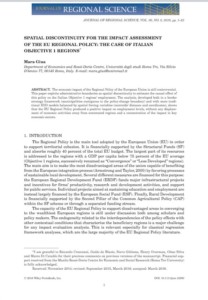 Mara Giua (2016)a, Spatial discontinuity for the impact assessment of the EU Regional policy. The case of the Italian Objective 1 regions, Journal of Regional Science, DOI: 10.1111/jors.12300 (2016).†
Mara Giua (2016)a, Spatial discontinuity for the impact assessment of the EU Regional policy. The case of the Italian Objective 1 regions, Journal of Regional Science, DOI: 10.1111/jors.12300 (2016).†
First published: 16 August 2016
a Department of Economics and Rossi-Doria Centre, Roma Tre University
† I am grateful to Riccardo Crescenzi, Guido de Blasio, Steve Gibbons, Henry Overman, Olmo Silva and Marco Di Cataldo for their precious comments on previous versions of the manuscript. Financial support received from the Manlio Rossi-Doria Centre for Economic and Social Research (Roma Tre University) is fully acknowledged.
Abstract. The economic impact of the Regional Policy of the European Union is still controversial. This paper exploits administrative boundaries as spatial discontinuity to estimate the causal effect of this policy on the Italian Objective 1 regions’ employment. The analysis, developed both in a border strategy framework (municipalities contiguous to the policy-change boundary) and with more traditional RDD models balanced by spatial forcing variables (centroids’ distance and coordinates), shows that the EU Regional Policy produced a positive impact on employment levels, without any displacement of economic activities away from nontreated regions and a concentration of the impact in key economic sectors.


